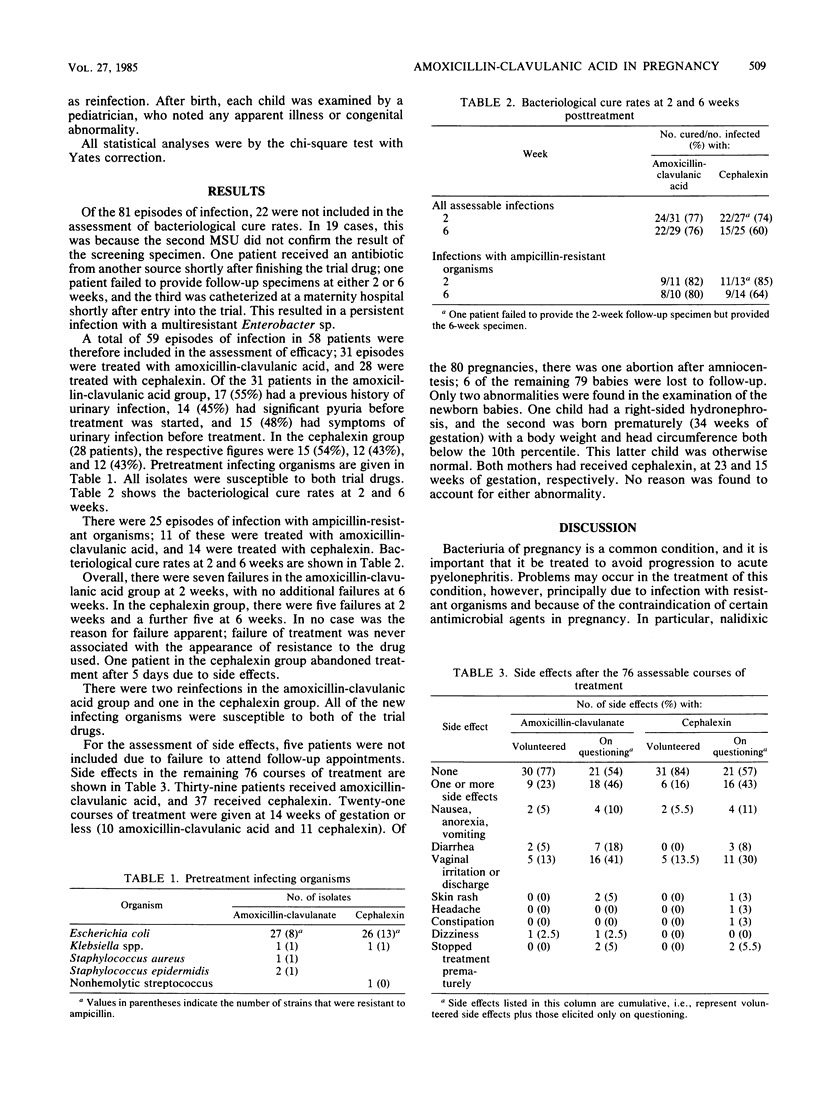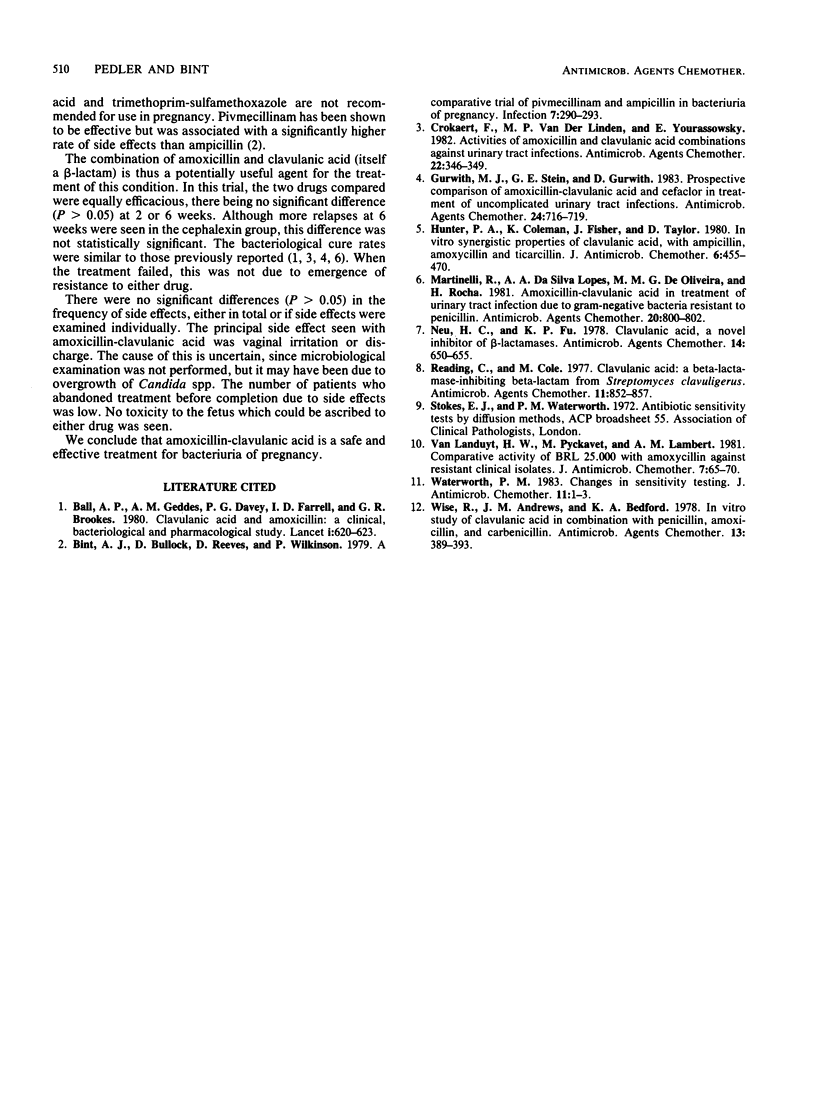Abstract
A comparative clinical trial of amoxicillin-clavulanic acid and cephalexin was carried out in 80 women with bacteriuria of pregnancy. Treatment was randomly allocated and consisted of either one tablet of amoxicillin plus clavulanic acid (250 and 125 mg, respectively) three times daily or cephalexin (250 mg) three times daily for 7 days. Overall bacteriological cure rates at 2 weeks were 77% in the amoxicillin-clavulanic acid group and 74% in the cephalexin group. At 6 weeks the respective rates were 76 and 60%. Twenty-five episodes of infection were with ampicillin-resistant strains; cure rates were 82% (2 weeks) and 80% (6 weeks) in the amoxicillin-clavulanic acid group and 85 and 64%, respectively, in the cephalexin group. Differences in cure rates were not statistically significant. No significant difference in the rate of side effects was found. In particular, no toxicity to the fetus was seen which could be ascribed to either drug. Amoxicillin-clavulanic acid would appear to be a safe and effective treatment for bacteriuria of pregnancy.
Full text
PDF


Selected References
These references are in PubMed. This may not be the complete list of references from this article.
- Ball A. P., Geddes A. M., Davey P. G., Farrell I. D., Brookes G. R. Clavulanic acid and amoxycillin: a clinical, bacteriological, and pharmacological study. Lancet. 1980 Mar 22;1(8169):620–623. doi: 10.1016/s0140-6736(80)91118-6. [DOI] [PubMed] [Google Scholar]
- Bint A., Bullock D., Reeves D., Wilkinson P. A comparative trial of pivmecillinam and ampicillin in bacteriuria of pregnancy. Infection. 1979;7(6):290–293. doi: 10.1007/BF01642151. [DOI] [PubMed] [Google Scholar]
- Crokaert F., van der Linden M. P., Yourassowsky E. Activities of amoxicillin and clavulanic acid combinations against urinary tract infections. Antimicrob Agents Chemother. 1982 Aug;22(2):346–349. doi: 10.1128/aac.22.2.346. [DOI] [PMC free article] [PubMed] [Google Scholar]
- Gurwith M. J., Stein G. E., Gurwith D. Prospective comparison of amoxicillin-clavulanic acid and cefaclor in treatment of uncomplicated urinary tract infections. Antimicrob Agents Chemother. 1983 Nov;24(5):716–719. doi: 10.1128/aac.24.5.716. [DOI] [PMC free article] [PubMed] [Google Scholar]
- Hunter P. A., Coleman K., Fisher J., Taylor D. In vitro synergistic properties of clavulanic acid, with ampicillin, amoxycillin and ticarcillin. J Antimicrob Chemother. 1980 Jul;6(4):455–470. doi: 10.1093/jac/6.4.455. [DOI] [PubMed] [Google Scholar]
- Martinelli R., Lopes A. A., de Oliveira M. M., Rocha H. Amoxicillin-clavulanic acid in treatment of urinary tract infection due to gram-negative bacteria resistant to penicillin. Antimicrob Agents Chemother. 1981 Dec;20(6):800–802. doi: 10.1128/aac.20.6.800. [DOI] [PMC free article] [PubMed] [Google Scholar]
- Neu H. C., Fu K. P. Clavulanic acid, a novel inhibitor of beta-lactamases. Antimicrob Agents Chemother. 1978 Nov;14(5):650–655. doi: 10.1128/aac.14.5.650. [DOI] [PMC free article] [PubMed] [Google Scholar]
- Reading C., Cole M. Clavulanic acid: a beta-lactamase-inhiting beta-lactam from Streptomyces clavuligerus. Antimicrob Agents Chemother. 1977 May;11(5):852–857. doi: 10.1128/aac.11.5.852. [DOI] [PMC free article] [PubMed] [Google Scholar]
- Van Landuyt H. W., Pyckavet M., Lambert A. M. Comparative activity of BRL 25.000 with amoxycillin against resistant clinical isolates. J Antimicrob Chemother. 1981 Jan;7(1):65–70. doi: 10.1093/jac/7.1.65. [DOI] [PubMed] [Google Scholar]
- Waterworth P. M. Changes in sensitivity testing. J Antimicrob Chemother. 1983 Jan;11(1):1–3. doi: 10.1093/jac/11.1.1. [DOI] [PubMed] [Google Scholar]
- Wise R., Andrews J. M., Bedford K. A. In vitro study of clavulanic acid in combination with penicillin, amoxycillin, and carbenicillin. Antimicrob Agents Chemother. 1978 Mar;13(3):389–393. doi: 10.1128/aac.13.3.389. [DOI] [PMC free article] [PubMed] [Google Scholar]


